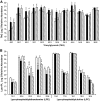Deletion of GPR40 impairs glucose-induced insulin secretion in vivo in mice without affecting intracellular fuel metabolism in islets
- PMID: 19720802
- PMCID: PMC2768167
- DOI: 10.2337/db09-0362
Deletion of GPR40 impairs glucose-induced insulin secretion in vivo in mice without affecting intracellular fuel metabolism in islets
Abstract
Objective: The G-protein-coupled receptor GPR40 mediates fatty acid potentiation of glucose-stimulated insulin secretion, but its contribution to insulin secretion in vivo and mechanisms of action remain uncertain. This study was aimed to ascertain whether GPR40 controls insulin secretion in vivo and modulates intracellular fuel metabolism in islets.
Research design and methods: Insulin secretion and sensitivity were assessed in GPR40 knockout mice and their wild-type littermates by hyperglycemic clamps and hyperinsulinemic euglycemic clamps, respectively. Transcriptomic analysis, metabolic studies, and lipid profiling were used to ascertain whether GPR40 modulates intracellular fuel metabolism in islets.
Results: Both glucose- and arginine-stimulated insulin secretion in vivo were decreased by approximately 60% in GPR40 knockout fasted and fed mice, without changes in insulin sensitivity. Neither gene expression profiles nor intracellular metabolism of glucose and palmitate in isolated islets were affected by GPR40 deletion. Lipid profiling of isolated islets revealed that the increase in triglyceride and decrease in lyso-phosphatidylethanolamine species in response to palmitate in vitro was similar in wild-type and knockout islets. In contrast, the increase in intracellular inositol phosphate levels observed in wild-type islets in response to fatty acids in vitro was absent in knockout islets.
Conclusions: These results indicate that deletion of GPR40 impairs insulin secretion in vivo not only in response to fatty acids but also to glucose and arginine, without altering intracellular fuel metabolism in islets, via a mechanism that may involve the generation of inositol phosphates downstream of GPR40 activation.
Figures





 , knockout control;
, knockout control;  , knockout palmitate.
, knockout palmitate.
Similar articles
-
G protein-coupled receptor (GPR)40-dependent potentiation of insulin secretion in mouse islets is mediated by protein kinase D1.Diabetologia. 2012 Oct;55(10):2682-2692. doi: 10.1007/s00125-012-2650-x. Epub 2012 Jul 22. Diabetologia. 2012. PMID: 22820510 Free PMC article.
-
Selective small-molecule agonists of G protein-coupled receptor 40 promote glucose-dependent insulin secretion and reduce blood glucose in mice.Diabetes. 2008 Aug;57(8):2211-9. doi: 10.2337/db08-0130. Epub 2008 May 13. Diabetes. 2008. PMID: 18477808 Free PMC article.
-
GPR40 is necessary but not sufficient for fatty acid stimulation of insulin secretion in vivo.Diabetes. 2007 Apr;56(4):1087-94. doi: 10.2337/db06-1532. Diabetes. 2007. PMID: 17395749 Free PMC article.
-
Regulatory Role of Fatty Acid Metabolism on Glucose-Induced Changes in Insulin and Glucagon Secretion by Pancreatic Islet Cells.Int J Mol Sci. 2024 May 31;25(11):6052. doi: 10.3390/ijms25116052. Int J Mol Sci. 2024. PMID: 38892240 Free PMC article. Review.
-
Lipid receptors and islet function: therapeutic implications?Diabetes Obes Metab. 2009 Nov;11 Suppl 4(Suppl 4):10-20. doi: 10.1111/j.1463-1326.2009.01114.x. Diabetes Obes Metab. 2009. PMID: 19817784 Free PMC article. Review.
Cited by
-
Diminished acyl-CoA synthetase isoform 4 activity in INS 832/13 cells reduces cellular epoxyeicosatrienoic acid levels and results in impaired glucose-stimulated insulin secretion.J Biol Chem. 2013 Jul 26;288(30):21618-29. doi: 10.1074/jbc.M113.481077. Epub 2013 Jun 13. J Biol Chem. 2013. PMID: 23766516 Free PMC article.
-
Endogenous Ligand for GPR120, Docosahexaenoic Acid, Exerts Benign Metabolic Effects on the Skeletal Muscles via AMP-activated Protein Kinase Pathway.J Biol Chem. 2015 Aug 14;290(33):20438-47. doi: 10.1074/jbc.M115.657379. Epub 2015 Jul 1. J Biol Chem. 2015. PMID: 26134561 Free PMC article.
-
Drug discovery opportunities and challenges at g protein coupled receptors for long chain free Fatty acids.Front Endocrinol (Lausanne). 2012 Jan 3;2:112. doi: 10.3389/fendo.2011.00112. eCollection 2011. Front Endocrinol (Lausanne). 2012. PMID: 22649399 Free PMC article.
-
Elevated nocturnal NEFA are an early signal for hyperinsulinaemic compensation during diet-induced insulin resistance in dogs.Diabetologia. 2015 Nov;58(11):2663-70. doi: 10.1007/s00125-015-3721-6. Epub 2015 Aug 9. Diabetologia. 2015. PMID: 26254577 Free PMC article.
-
Metabolite-Sensing G Protein-Coupled Receptors Connect the Diet-Microbiota-Metabolites Axis to Inflammatory Bowel Disease.Cells. 2019 May 14;8(5):450. doi: 10.3390/cells8050450. Cells. 2019. PMID: 31091682 Free PMC article. Review.
References
-
- Briscoe CP, Tadayyon M, Andrews JL, Benson WG, Chambers JK, Eilert MM, Ellis C, Elshourbagy NA, Goetz AS, Minnick DT, Murdock PR, Sauls HR, Jr, Shabon U, Spinage LD, Strum JC, Szekeres PG, Tan KB, Way JM, Ignar DM, Wilson S, Muir AI: The orphan G protein-coupled receptor GPR40 is activated by medium and long chain fatty acids J Biol Chem 2003; 278: 11303– 11311 - PubMed
-
- Itoh Y, Kawamata Y, Harada M, Kobayashi M, Fujii R, Fukusumi S, Ogi K, Hosoya M, Tanaka Y, Uejima H, Tanaka H, Maruyama M, Satoh R, Okubo S, Kizawa H, Komatsu H, Matsumura F, Noguchi Y, Shinohara T, Hinuma S, Fujisawa Y, Fujino M: Free fatty acids regulate insulin secretion from pancreatic beta cells through GPR40 Nature 2003; 422: 173– 176 - PubMed
MeSH terms
Substances
Grants and funding
LinkOut - more resources
Full Text Sources
Other Literature Sources
Medical
Molecular Biology Databases

